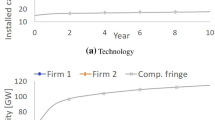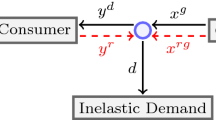Abstract
We extend the theory of peak-load pricing by considering that the production with different technologies can be adjusted within their capacity at different speeds. In the established analysis, all production decisions can be made after the random variables realize. In our setting, in contrast, some decisions are made before, others after. This is important, e.g., when increasing capacities of renewables are integrated in electricity systems worldwide. We consider fixed load and three types of capacities: partially dispatchable capacity (e.g., nuclear power-plants) needs to be scheduled ahead of actual production, non-dispatchable capacity (e.g., wind turbines) produces randomly, and highly-dispatchable capacity (e.g., gas turbines) can instantly adjust. If capacities differ in their dispatchability, some standard results of peak-load pricing break down. For example, less capacity types will be employed. Either a system with partially dispatchable technologies only, or a system dominated by non-dispatchable technologies and supplemented by highly-dispatchables occurs. Non- and highly dispatchable technologies can be substitutes or complements. The probability of outage does not rise if non-dispatchable capacity becomes cheaper. In a system with non-dispatchables, capacity decisions cannot be decentralized by conventional markets because cost recovery is not possible. Thus, the integration of renewable electricity generators requires alternative market designs.

Similar content being viewed by others
Notes
In the simple case where only partially dispatchable capacity is employed, we have \(k_{P}=D\). Only the parameters \(b_{P},c_{P}\) are relevant. Marginal utility is equal to LRMC of partially dispatchable technologies, demand decreases in \(b_{P},c_{P}\), and \(\frac{\partial k_{P}}{\partial b_{P}},\frac{\partial k_{P}}{\partial c_{P}}<0\).
Such a specification better reflects characteristics of renewable generators. Wind turbines and PV power stations can easily turn off production in case of excess supply.
We can also combine downward-dispatchability with multiple periods, as in Proposition 4. Results do not differ qualitatively for both stochastically independent and perfectly correlated marginal generating units.
References
Alayo, H., & García, R. (2015). A static deterministic linear peak-load pricing model for the electricity industry: Application to the peruvian case. Energy Economics, 50, 202–206.
Allcott, H., Collard-Wexler, A., & O’Connell, S. D. (2016). How do electricity shortages affect industry? Evidence from India. American Economic Review, 106(3), 587–624.
Antweiler, W. (2017). A two-part feed-in-tariff for intermittent electricity generation. Energy Economics, 65, 458–470.
Boiteux, M. (1949). La tarification des demandes en point: Application de la theorie de la vente au cout marginal. Revue Generale de l’Electicite, 58, 321–340; 1960 translated as “Peak Load Pricing” in Journal of Business, 33(2), 157–179.
Borenstein, S. (2016). The economics of fixed cost recovery by utilities. The Electricity Journal, 29(7), 5–12.
Borenstein, S., & Holland, S. (2005). On the efficiency of competitive electricity markets with time-invariant retail prices. RAND Journal of Economics, 36(3), 469–93.
Borggrefe, F., & Neuhoff, K. (2011). Balancing and intraday market design: Options for wind integration. DIW Berlin discussion paper no. 1162. SSRN: https://doi.org/10.2139/ssrn.1945724.
Brown, D. P. (2018). Capacity payment mechanisms and investment incentives in restructured electricity markets. Energy Economics, 74, 131–142.
Brown, G., & Johnson, M. B. (1969). Public utility pricing and output under risk. American Economic Review, 59(1), 119–128.
Bushnell, J., Flagg, M., & Mansur, E. (2017). Capacity markets at a crossroads. Washington, DC: Report to the Department of Energy, Office of Energy Policy and Systems Analysis.
Carlton, D. W. (1977). Peak load pricing with stochastic demand. American Economic Review, 67(5), 1006–1010.
Chao, H. P. (1983). Peak load pricing and capacity planning with demand and supply uncertainty. Bell Journal of Economics, 14(1), 179–190.
Chao, H. P. (2011). Efficient pricing and investment in electricity markets with intermittent resources. Energy Policy, 39(7), 3945–3953.
Crampes, C., & Renault, J. (2019). How many markets for wholesale electricity when supply is partially flexible? Energy Economics, 81, 465–478.
Cramton, P., Ockenfels, A., & Stoft, S. (2013). Capacity market fundamentals. Economics of Energy and Environmental Policy, 2(2), 27–46.
Crew, M. A., Fernando, C. S., & Kleindorfer, P. R. (1995). The theory of peak-load pricing: A survey. Journal of Regulatory Economics, 8(3), 215–248.
Crew, M. A., & Kleindorfer, P. R. (1971). Marshall and Turvey on peak load or joint product pricing. Journal of Political Economy, 79(6), 1369–1377.
Crew, M. A., & Kleindorfer, P. R. (1976). Peak load pricing with a diverse technology. Bell Journal of Economics, 7(1), 207–231.
Eisenack, K. (2016). Institutional adaptation to cooling water scarcity in the electricity sector under global warming. Ecological Economics, 124, 153–163.
Eisenack, K., & Mier, M. (2019). Technical appendix of “Peak-load pricing with different types of dispatchability”. SSRN: https://ssrn.com/abstract=3487446.
Fabra, N. (2018). A primer on capacity mechanisms. Energy Economics, 75, 323–335.
Fabra, N., Von der Fehr, N. H. M., & De Frutos, M. Á. (2011). Market design and investment incentives. The Economic Journal, 121(557), 1340–1360.
Gimeno-Gutiérrez, M., & Lacal-Arántegui, R. (2015). Assessment of the European potential for pumped hydropower energy storage based on two existing reservoirs. Renewable Energy, 75, 856–868.
Göransson, L., Goop, J., Odenberger, M., & Johnsson, F. (2017). Impact of thermal plant cycling on the cost-optimal composition of a regional electricity generation system. Applied Energy, 197, 230–240.
Green, R. J., & Léautier, T. O. (2017). Do costs fall faster than revenues? Dynamics of renewables entry into electricity markets. TSE working paper, no 15-591, revised version.
Hamborg, S., Meya, J. N., Eisenack, K., & Raabe, T. (2020). Rethinking resilience: A cross-epistemic resilience framework for interdisciplinary energy research. Energy Research and Social Science, 59, 101285.
Helm, C., & Mier, M. (2019). On the efficient market diffusion of intermittent renewable energies. Energy Economics, 80, 812–830.
Henriot, A., & Glachant, J. M. (2013). Melting-pots and salad bowls: The current debate on electricity market design for integration of intermittent res. Utilities Policy, 27, 57–64.
Hiroux, C., & Saguan, M. (2010). Large-scale wind power in european electricity markets: Time for revisiting support schemes and market designs? Energy Policy, 38(7), 3135–3145.
Hirth, L. (2013). The market value of variable renewables: The effect of solar wind power variability on their relative price. Energy Economics, 38, 218–236.
Hortaçsu, A., & Puller, S. L. (2008). Understanding strategic bidding in multi-unit auctions: A case study of the texas electricity spot market. RAND Journal of Economics, 39(1), 86–114.
IEA. (2015). Projected costs of generating electricity 2015 edition. Technical report. International Energy Agency.
IRENA. (2016). The power to change: Solar and wind cost reduction potential to 2025. Technical report. International Renewable Energy Agency.
Ito, K. (2014). Do consumers respond to marginal or average price? Evidence from nonlinear electricity pricing. American Economic Review, 104(2), 537–563.
Joskow, P. L. (2008). Capacity payments in imperfect electricity markets: Need and design. Utilities Policy, 16(3), 159–170.
Joskow, P. L., & Tirole, J. (2007). Reliability and competitive electricity markets. RAND Journal of Economics, 38(1), 60–84.
Kleindorfer, P. R., & Fernando, C. S. (1993). Peak-load pricing and reliability under uncertainty. Journal of Regulatory Economics, 5(1), 5–23.
Kubik, M., Coker, P., & Barlow, J. (2015). Increasing thermal plant flexibility in a high renewables power system. Applied Energy, 154, 102–111.
Kumano, T. (2011). A functional optimization based dynamic economic load dispatch considering ramping rate of thermal units output. In Power systems conference and exposition (pp. 1–8).
Kumar, N., Besuner, P., Lefton, S., & Agan, D. (2012). Power plant cycling costs. Technical report. NREL.
Lamont, A. D. (2008). Assessing the long-term system value of intermittent electric generation technologies. Energy Economics, 30(3), 1208–1231.
Lannoye, E., Flynn, D., & O’Malley, M. (2012). Evaluation of power system flexibility. IEEE Transactions on Power Systems, 27(2), 922–931.
Luo, X., Wang, J., Dooner, M., & Clarke, J. (2015). Overview of current development in electrical energy storage technologies and the application potential in power system operation. Applied Energy, 137, 511–536.
Mier, M. (2018). Policy implications of a world with renewables, limited dispatchability, and fixed load. Oldenburg discussion papers in economics V-412-18, revised version 2019 “Efficient pricing of electricity revisited”. SSRN: http://dx.doi.org/10.2139/ssrn.3477824.
Müsgens, F., Ockenfels, A., & Peek, M. (2014). Economics and design of balancing power markets in Germany. International Journal of Electrical Power and Energy Systems, 55, 392–401.
Neetzow, P. (2019). How to go green? The effects of power system flexibility on the efficient transition to renewable generation. Working papers of the Department of Agricultural Economics 96/2019, Humboldt-Universität zu Berlin.
Neetzow, P., Pechan, A., & Eisenack, K. (2018). Electricity storage and transmission: Complements or substitutes? Energy Economics, 76, 367–377.
Newbery, D. (2010). Market design for a large share of wind power. Energy Policy, 38(7), 3131–3134.
Newbery, D. (2016). Missing money and missing markets: Reliability, capacity auctions and interconnectors. Energy Policy, 94, 401–410.
Pechan, A. (2017). Where do all the windmills go? Influence of the institutional setting on the spatial distribution of renewable energy installation. Energy Economics, 65, 75–86.
Pechan, A., & Eisenack, K. (2014). The impact of heat waves on electricity spot markets. Energy Economics, 43, 63–71.
Reichelstein, S., & Sahoo, A. (2015). Time of day pricing and the levelized cost of intermittent power generation. Energy Economics, 48, 97–108.
REN21. (2018). Renewables 2018 global status report. Technical report, Paris: REN21 Secretariat.
Schill, W. P., Pahle, M., & Gambardella, C. (2017). Start-up costs of thermal power plants in markets with increasing shares of variable renewable generation. Nature Energy, 2(17050), 1–6.
Schmid, E., Pechan, A., Mehnert, M., & Eisenack, K. (2017). Imagine all these futures: On heterogeneous preferences and mental models in the german energy transition. Energy Research and Social Science, 27, 45–56.
Schmidt, O., Hawkes, A., Gambhir, A., & Staffell, I. (2017). The future cost of electrical energy storage based on experience rates. Nature Energy, 2(17110), 1–8.
Schröder, A., Kunz, F., Meiss, J., Mendelevitch, R., & Von Hirschhausen, C. (2013). Current and prospective costs of electricity generation until 2050. DIW data documentation 68. Berlin: Deutsches Institut für Wirtschaftsforschung.
Steiner, P. O. (1957). Peak loads and efficient pricing. The Quarterly Journal of Economics, 71(4), 585–610.
Turvey, R., & Anderson, D. (1977). Electricity economics: Essays and case studies. Baltimore: Johns Hopkins University Press.
Van den Bergh, K., & Delarue, E. (2015). Cycling of conventional power plants: Technical limits and actual costs. Energy Conversion and Management, 97, 70–77.
Visscher, M. L. (1973). Welfare-maximizing price and output with stochastic demand: Comment. American Economic Review, 63(1), 224–229.
Wang, C., & Shahidehpour, S. (1995). Optimal generation scheduling with ramping costs. IEEE Transactions on Power Systems, 10(1), 60–67.
Williamson, O. E. (1966). Peak-load pricing and optimal capacity under indivisibility constraints. American Economic Review, 56(4), 810–827.
Zerrahn, A., Schill, W. P., & Kemfert, C. (2018). On the economics of electrical storage for variable renewable energy sources. European Economic Review, 108, 259–279.
Acknowledgements
We are indebted to Carsten Helm, Sebastian Schwenen, and an anonymous referee for helpful comments. Additionally, we thank several colleagues at the Department for Economics and Statistics, University of Oldenburg, for their feedback. Substantial parts of this paper were developed there. We finally thank for feedback obtained on various conferences and research seminars.
Author information
Authors and Affiliations
Corresponding author
Ethics declarations
Conflict of interest
The authors declare that they have no conflict of interest.
Additional information
Publisher's Note
Springer Nature remains neutral with regard to jurisdictional claims in published maps and institutional affiliations.
Part of this work was supported by the German Ministry of Education and Research (Grant No. 03EK3523) and Volkswagen Foundation (Grant No. VWZN3045).
Rights and permissions
About this article
Cite this article
Eisenack, K., Mier, M. Peak-load pricing with different types of dispatchability. J Regul Econ 56, 105–124 (2019). https://doi.org/10.1007/s11149-019-09394-9
Published:
Issue Date:
DOI: https://doi.org/10.1007/s11149-019-09394-9
Keywords
- Cost recovery
- Dispatchability
- Energy transition
- Flexibility
- Market design
- Peak-load pricing
- Reliability
- Renewables




